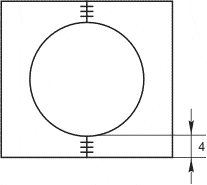Any TV, including those that are not Smart TV devices, have service menu, which controls vital settings. In particular, the horizontal and vertical image size, brightness correction, as well as other parameters that can seriously affect the operation of the device. Therefore, if you don’t understand how and what to do, it’s better to leave this service altogether.
It is not surprising that the service menu on Samsung TV is usually called extended, because it is used if you need to make major changes in the operation of the TV itself. And to use it, you need to have a special remote control remote control. Moreover, it is important that it be “native” to the TV, that is, it comes with it. Otherwise, even if you get to the menu, it will be difficult to stay there, since the controls are not reliable.
What are the functions of the Samsung TV service menu?
As already mentioned, to the average user It is not recommended to experiment with the service menu on Smart TV, including Samsung K series or any other series, even J. The point is not that this is a whim of the developers. On the contrary, users can press the wrong key on the remote control, and all settings will be lost, which will lead to a complete loss of normal operation of expensive equipment.
But in the hands of a master who has entered the service menu of TVs, it can turn a standard Smart TV into almost home cinema. However, sometimes such settings can be opened completely by accident, involuntarily pressing some key combination. If this happens, you can change:
- Spectrum of the image, for example, by choosing a green or red palette, in connection with which the picture on the screen will become a country. Few people want to watch TV in this format.
- Screen image size options. It may turn out that the picture will not occupy the entire screen, but only half of it, from the bottom, top or side. The picture may break into pixels and undergo other, unpleasant changes.
- Naturally, the service menu Samsung TV can change the sound parameters, making it so that even at the highest volume, the device is barely audible. Or it uses various sound effects, which can cause an echo and increase acoustics, which also does not contribute to comfortable viewing of the content.
- In addition, once in the service menu of a Samsung TV, you can connect and disable various built-in functions.
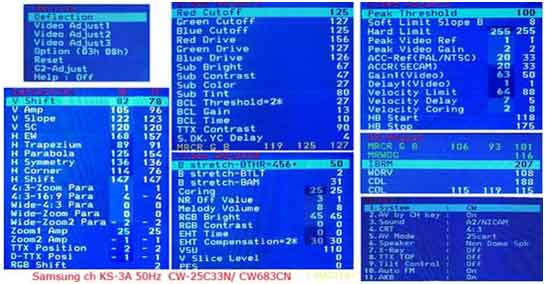 In general, if the user needs to change some automatic settings, this is done here.
In general, if the user needs to change some automatic settings, this is done here.
How to get to the service menu of Samsung TV 6
In order to go to the service menu you need to perform a few simple manipulations. But they are only available if you have a remote control. For some models, a standard remote control is suitable, like for Samsung 5, or you will have to use a special remote control, which is not included in the kit, and will need to be purchased separately. But this is not a problem, because there are many service stores.
- Take the remote control and press the following sequence: info – menu – mute – power;
- Having found out how to enter the service, you need to wait a couple of seconds, since the TV, after pressing the specified combination, will reboot to display the necessary information;
- After this, the person entering must learn to move in such a way as not to accidentally change the settings. If you need to change something, you need to press “Enter” and only then make amendments;
- Go to “Control”, “Cloning” and so on;
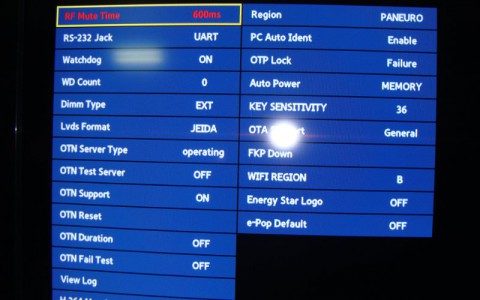 It is important to check “OFF” before finishing work in the “Hotel Option” section to protect some functions from failure. And also, since the user has entered the menu and knows how to enter here at any time, he also needs to understand how to exit without damaging the settings. This is done this way:
It is important to check “OFF” before finishing work in the “Hotel Option” section to protect some functions from failure. And also, since the user has entered the menu and knows how to enter here at any time, he also needs to understand how to exit without damaging the settings. This is done this way:
- You can exit by simply turning off the TV;
- Then we go back to MENU-SYSTEM and see what has changed;
- If everything is fine, we entered without problems and the settings are fine, which means that we can continue to use the TV with the updated menu.
Hello dear readers! In this article we will talk about the holy of holies -.
Although it would be more correct to say here in the plural, since several model series of different years will be considered.
You may have a question: “Why should I, to a simple user, go to the service menu? After all, this is very dangerous, you can completely kill the TV.”
And here it is difficult to disagree. Indeed, unless absolutely necessary, it’s absolutely not worth it to just “rummage” through the settings of the engineering menu. If you don’t have a clue, you’re going to mess things up there, then maybe service center then don't take it up.
From the above, the conclusion suggests itself: why go there and is it really so dangerous? Well, I asked myself, I will answer myself.
So, why do we go into the service menu of a Samsung TV:
- If you bought a TV abroad (for example, in Poland) and it does not have Russian language.
- If your TV has Russian language, but Smart TV is blocked, or Russian-language widgets are not available for installation.
That is, in the service menu settings we will look for the Russian language (if it is absent) and remove the Smart Hub block.
Now about the danger: if you do everything exactly according to the instructions from the article, everything will be fine. You will enjoy using your “zombie box” for a long time. 🙂
As you already understand, the article will be mega-useful for people who brought their TVs from abroad. They are the ones who often face similar problems.
If you bought your “Male” from an official representative in your city, you should not face these problems. The seller has already made all the necessary settings.
After reading the article, you will learn:
So you bought a TV Samsung Smart TV somewhere abroad (usually in Poland), you read about it and now want to enjoy all the delights of “smart” technologies.
No problem, let's get started.
Turn on your TV and press the "Smart Hub" button on the remote control:
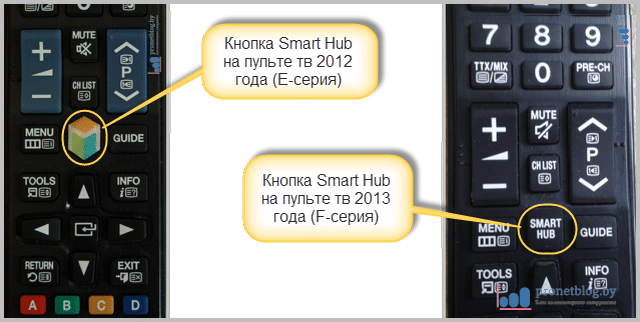 At this step, you may have two ways of developing things.
At this step, you may have two ways of developing things.
First. When you run it for the first time, you may see a message like this:
This product and accompanying software and services (including Samsung Smart Hub) are specifically designed fore users residing in the EU.
As Smart Hub is geo-blocked for this particular product, Samsung Smart Hub may not be available in your current location.
This means that you have blocked Smart TV functions for your region. That is, according to the manufacturer’s intention, your TV should not have entered the country in which it is actually located.
If this is your situation, then there is no need to panic. Everything is resolved quite simply - throughout the article, everything is told and shown.
If you have not received such a message, but the full Smart Hub menu has opened, go straight to our writing. Everything is much simpler there. 🙂
So, when the TV displays the message indicated above, the first thing to do is check the presence of the Russian language in the TV settings menu.
Let's check it using the example of Samsung UE40ES6100 (E-series 2012). Press the "Menu" button on the control panel:

Then follow the path "System - Language":
 Now look for Russian in the list:
Now look for Russian in the list:

If it does show up (while the Smart TV is blocked), it means the seller has not set the necessary settings in the engineering menu quite correctly for your actual region of residence. From this we conclude:
- If your Smart Hub is blocked, you must definitely change the region of the TV itself using the SM settings.
- If everything works and the language is Russian, it is not recommended to change the installed SM parameters at all.
Well, if there is no language, then you need to unlock the Smart Hub and change the TV region to yours in order to Russify it. And this is done, as mentioned above, only by changing the parameters of the engineering menu.
There are a few simple ways how this can be done. But depending on the build of your TV and the features of the firmware, the same method may or may not work on the same TV model.
That is why the author provides several methods. Use them in the order given in the article - from the simplest to the more complex. That is, you tried the first method, it didn’t work on your TV, try the second and so on.
But before you start studying the service menu of your Samsung TV, carefully read the following parting words:
- You do all operations in the TV service menu at your own peril and risk. Remember that any deviation from the instructions, or an erroneous action due to negligence, can kill your TV.
- If you are not confident in your abilities, or do not quite understand what is being said, it is better not to try. The consequences can be very upsetting.
- If you decide to do it yourself, then set the parameters in the service menu strictly according to the instructions and take pictures of the initial appearance of the settings.
- If you did everything according to the instructions, but nothing worked, read the comments to the article. Perhaps there you will find a suitable solution for your TV.
If you have difficulty determining the series and year of release of your TV, carefully read the article about. For a general idea of working in SM, watch the video below carefully:
Samsung TV service menu C-D-E-F series (unlock)
In order to unlock the Smart Hub and add the Russian language to the menu of TV models 2010-2012. ( C-D-E series) do the following.
Let's look at the service menu of the Samsung UE40ES6100 TV as an example.
Method number 1: using the TV remote control.
With the TV turned off, press the sequential combination of buttons "Info - Menu - Mute - Power" on the remote control:
The TV will turn on and the service menu will open.
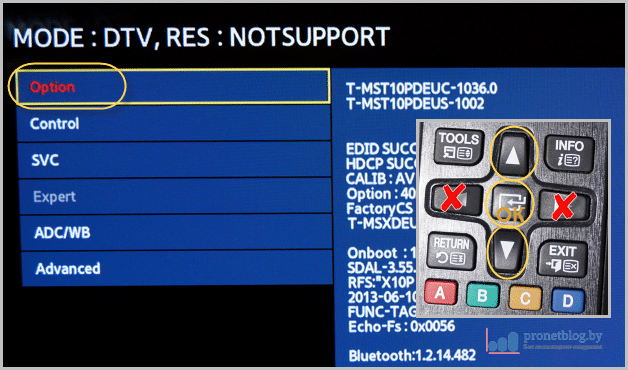

To exit the engineering menu, press the "Power" button, turning off the TV:
Now turn on the TV again, press "Menu" on the remote control and follow the path "System - Language":
 Now select Russian from the list:
Now select Russian from the list:
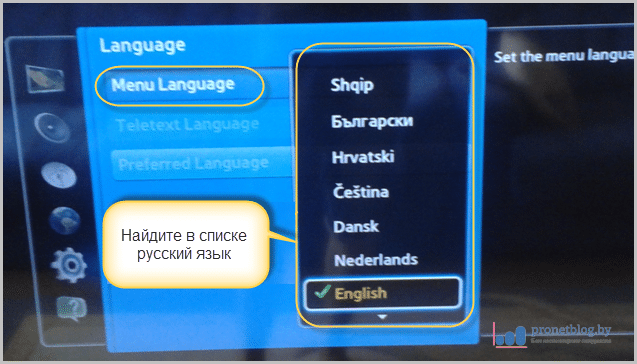
Follow the path" Control - Sub option" and set the parameters "RS-232 Jack -Debug" and "Watchdog - Off":
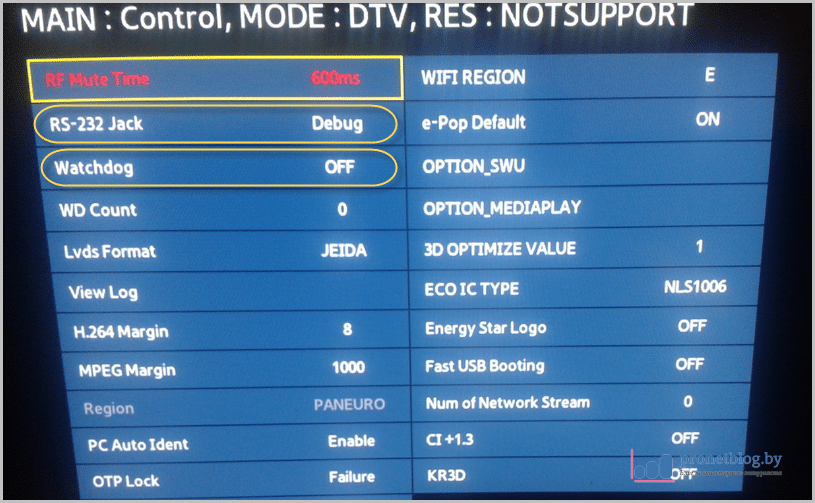
This will enable the service port and error timer, which will automatically reboot the system in case of critical indicators.
But sometimes it happens that the “Local Set” parameter in the service menu of a Samsung TV is inactive and cannot be changed. At the factory, this feature is closed in the firmware.
Well, let's try the next method.
Method number 2: using the software console ruSamsungTVCommunicator.
This method works on many 2011-2013 models. (D-E-F series).
This program allows you to fully control your TV from your computer. Also allows you to access the extended service menu. So, download the above application on your computer.
Naturally, the computer and the TV must be on the same network and see each other. We talked about how to do this correctly in.
Turn on the TV and use the "Source" button on the remote control to switch it to "TV" mode:

Return to the computer. Disable your antivirus (firewall) so that it does not block the program when it detects the TV.
Now unpack the downloaded archive with the program and run it by clicking on the file "ruSamsungTVCommunicator.exe":

The application will start and display several information windows in German. Agree everywhere, click "OK".
Then the program icon will appear in the system tray and will scan the TV for several minutes:

Wait until the following message is displayed and press the "Weiter" button:

Now in the folder with the program files the file “ruSamsungTVCommunicator.ini” will be created with the settings for connecting to your TV:

Knowing this data initially, you can enter it to avoid lengthy scanning when you first start the program.
Now go to the TV. You will see a request to add a new device on the screen. Click "Allow":

At this time, a virtual console will open on the computer. Click on it the sequence of buttons "Info - Factory":
 Try to press quickly. If the service menu does not appear on the TV, repeat the combination several times.
Try to press quickly. If the service menu does not appear on the TV, repeat the combination several times.
After the menu has opened, use the TV remote control to select the “Option” item using the up-down arrows (the left-right buttons are the only ones used, the left-right buttons change parameters) and press the “OK” button (center key):

In the "Local Set" item, instead of the "EU" value, set the "CIS_RUSSIA" parameter:

Now press the "Return" button on the TV remote to go back a step and reset the system settings by pressing " Factory Reset", then "OK".
This step will reboot the TV, then enter the service menu again.
In order to add Russian language to the TV menu, go to "Control - Sub option" and specify the settings " Region - PANEURO" and "Language Arabic - CIS":
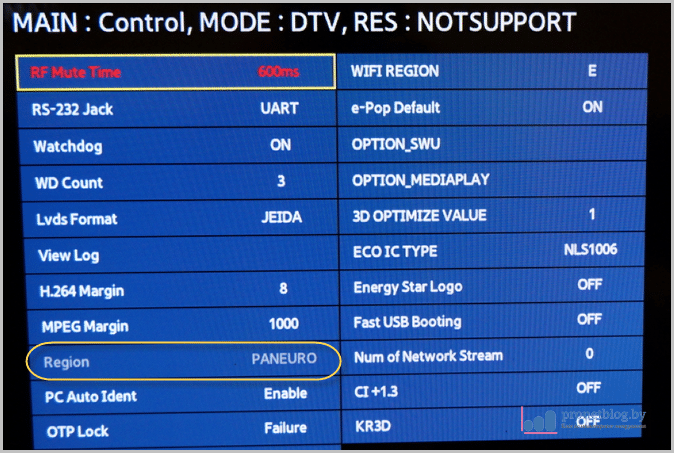
As you can see, in our case, when connecting with a software remote control, the second item is not available (it is simply not in the menu).
Now exit the TV service menu. Press the "Factory" button on the virtual remote control twice: 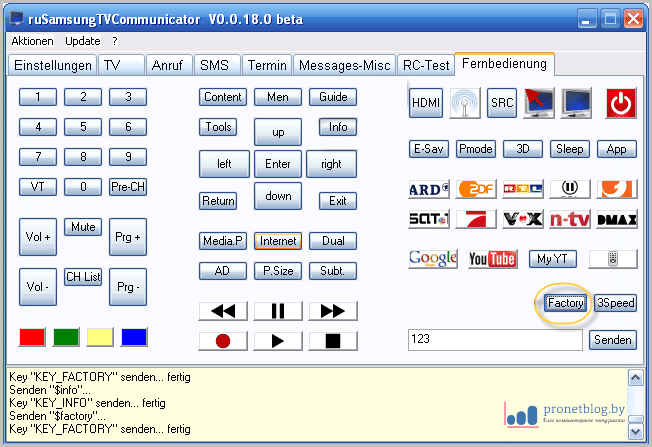
Follow the path" Control - Sub option" and specify the parameters "RS-232 Jack -Debug" and "Watchdog - Off":

If, using this method of entering the service menu of your Samsung TV, the “Local Set” parameter is inactive and cannot be changed (the option is closed at the factory), then proceed to the next method.
Method number 3: using infrared diodes and an old headphone cord.
This method is the most reliable. Calls up the extended service menu of TVs Samsung models 2010-2013 (C-D-E-F series).
The point is this. We take one LED (can be from an old unnecessary remote control) and connect its cathode to the right or left channel of the headphone plug (regular 3.5 mm mini-jack). We connect the LED anode and connect it to the ground of the plug.
This completes the installation work. Look how it looks schematically:
 In fact, everything worked out even without a soldering iron. The author of the article took a mini-jack - mini-jack cord and simply attached the diode legs to the plug at one end.
In fact, everything worked out even without a soldering iron. The author of the article took a mini-jack - mini-jack cord and simply attached the diode legs to the plug at one end.
It looks like this:

Temporary solution without a soldering iron:

You can, of course, solder it for convenience, but holding it for two seconds is not difficult. And also, I’m wildly sorry, but in the photo the anode is also mistakenly pressed against the sound channel. The mass is on the opposite side, under the thumb. 😉
As a cord, you can use a lot of options: just a headphone plug with a piece of wire, a 3.5 mm mini-jack cord - tulips, etc.
Is there some more second method manufacture of this device.
This time we take two LEDs and connect them in parallel according to the circuit: the cathode of the first - to the anode of the second, the anode of the first - to the cathode of the second.
Then we solder the whole thing to the sound channels of the headphone plug. In the diagram the design looks like this:
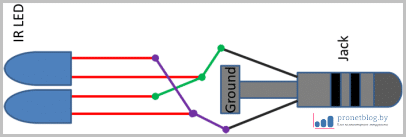
Of course, in this option you can’t do without a soldering iron.
By the way, if you don’t have diodes at hand, you can try the option with a factory infrared blaster, which comes with some Samsung models:

The functionality of this design is easy to check. Insert one end of the cord into the audio output of a computer or laptop, attach an LED to the second according to the diagram.
Now any sound file, turn the volume up to full and point the camera on mobile phone to the diode - it should glow.
Connect our simple design to your computer (laptop). Disable all equalizers in settings sound card and set maximum level volume:

IN Windows Player Media Player also set the volume to maximum, remove all equalizers and disable playback repeats:
Now let's take the whole thing to the TV. Turn it on and use the “Source” button to switch it to “TV” mode:

Point the LED at the TV receiver (the place where you point the remote control). The distance should be 10-15 cm:
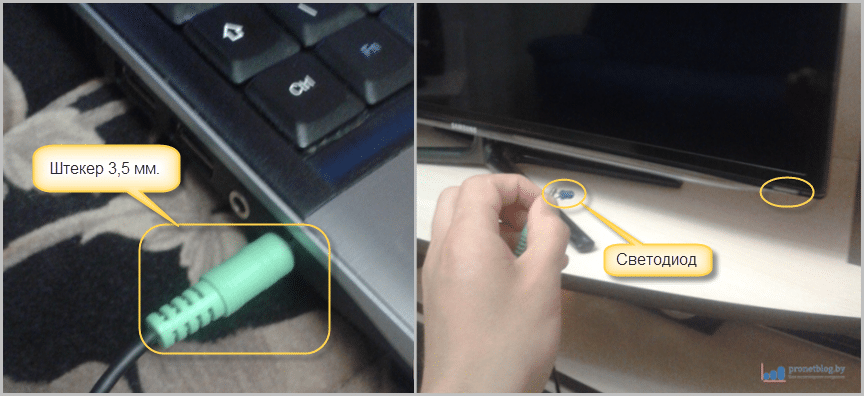
Run in Windows Media Player file "INFO_FACTORY_inv.wav" from the downloaded archive. After this, the TV will turn on and the service menu will open.
Using the up-down arrows (only them. The left-right buttons change parameters) select the “Option” item and press the “OK” button (central button):

In the "Local Set" item, instead of the "EU" value, set the "CIS_RUSSIA" parameter.
After this, press the "Return" button on the TV remote control to go back a step and reset the system settings by clicking "Factory Reset", then "OK":

The TV should now reboot itself. If not, turn it off with the "Power" button, and then go back to the service menu.
Follow the path" Control - Sub option" and specify the settings "RS-232 Jack -Debug" and "Watchdog - Off":

This will enable the service port and error timer, which will automatically reboot the system in case of critical indicators.
That's all, the Russian language will become available in the TV menu and the Smart Hub will be unlocked.
Method No. 4: an alternative option using the infrared blaster included with the TV. It works quite often.
1. In the first step, with the TV turned off, press the sequential combination of buttons “Info - Menu - Mute - Power” on the remote control. The service menu will open.
2. Now play the file “FACTORY+3SPEED_inv.wav” from the previously downloaded archive of service codes. At the same time, the TV screen should blink. If this does not happen, repeat the playback until you notice blinking. Then turn off the TV using the "Power" button on the remote control.
3. Now press the button combination “Info - Menu - Mute - Power” again to call up the engineering menu. But now in the “Option” menu the “Local Set” item, which we need so much, should become editable. 🙂
1. If you didn’t succeed the first time (“Local Set” did not appear), repeat the whole process again. Sometimes for some reason it doesn't work the first time.
2. If while playing the file "FACTORY+3SPEED_inv.wav" the TV went into test mode(the screen will begin to blink in different colors alternately), do not be alarmed. Just press up the joystick on back wall TV and everything will pass.
3. If, when using a blaster, the TV does not react to the codes at all, it means that the built-in sound card of your computer does not have enough power. Alternatively, connect it through an acoustic system with a built-in amplifier.
(unlock)
These instructions are relevant for 2014 TV models.
So, to enter the TV service menu Samsung H-series, you need to use homemade remote control on two diodes, or an infrared blaster from the TV set.
How to make such a remote control is described in great detail in the topic of changing the region on E and F series TVs (spoiler above). There is also a link to download an archive with sound service files that you will need in the future.
By the way, it is the “homemade” LED remote control that is preferred with this method of entering engineering menu, because the blaster on some TVs does not work.
If you have a tablet or Android smartphone at home, then good solution can serve as software for these devices.
Step #1. With the TV turned off, press the sequential combination of buttons "Info - Menu - Mute - Power" on the remote control:
The service menu will open, but not the extended one. The items necessary for Russification of the TV will not be available there. And now a very important parting word:
Before changing anything in SM, immediately take a photo of the initial settings of the “Option” and “MRT Option” sections.
Step #2. Already in the service menu, point the diodes (or blaster) at the TV receiver and run two files from the archive in Windows Media Player: "INFO_FACTORY inv.wav" and "FACTORY FROM REMOTE":

Playback should be cyclical, without pauses. As a result of these actions, the service menu should become expanded. That is, the “Local Set” item and the necessary lines in the “MRT Option” are activated.
If, after playing the above sound codes, the advanced engineering menu still does not open, try the following alternatives:
- Play in the "TV" mode (the "Source - TV" button) a pair of files "INFO.wav + FACTORY.wav".
- In "TV" mode, press the "INFO" button on the remote control and immediately play the file "FACTORY_from_REMOTE_inv.wav"
- The third option is alternative way input using the factory IR blaster included with the TV (method No. 4 under the spoiler above).
In practice, quite often, even for TVs of the same series and country of manufacture, they are completely suitable different ways. Therefore, everything here can only be decided experimentally. And if one doesn't work, move on to the next one.
Step #3. Using the up-down arrows (only them. The left-right buttons change the values of the rows), select “Option” and click “OK” (center button):

Now in the “Local Set” item you need to specify a value depending on the region where your TV is intended, namely:
- If the Smart Hub starts up for you, skip the “Local Set” item altogether. In this case, it is not recommended to change its value.
- For TV from Asia and Europe (series for Poland and Finland), with a blocked Smart Hub, specify the parameter "EA_CIS" (CIS_RUS).
- On TVs for other regions, do not use the above values yourself. There may be problems.

With this parameter, you indicated to the TV a digital tuner settings profile for a specific region and added the ability to install a Russian-language package. The prefix "CIS" means CIS countries.
Now exit the “Option” item using the “Return” button on the remote control and enter the “MRT Option” menu. In it, set the following settings: 
On the HU series of TVs, the “Region” and “Language_Arabic” items may not be available for editing. If this is exactly the situation you have, then skip them and do everything further exactly as indicated later in the article.
At this step, be sure to go to the second stage of settings and do everything according to the instructions “Setting up digital channels”.
Service menu for Samsung H-series TVs(setting up digital channels)
After changing the TV region (Local Set) and adding the ability to select the Russian language, be sure to check the digital channel settings.
To do this, go to the service menu along the path "Option - MRT Option" and check the following parameters:

For the HU series, you must compare all the available items in the “MRT Option” section with the original values in the photo and set them again if they change.
For a more complete understanding of the essence of the issue and the algorithm of actions, look at the example of successful setup of a Samsung UE55HU8500LXXH TV, one of the forum users samez.eu:

After this, press the "Return" button and return to the first page of the service menu and select the "Option" item:

Now press "Factory Reset" and "OK" (central button on the remote control):

At this step, the TV should automatically reboot. If not, turn it off with the "Power" button on the remote control, and then enter the service menu again.
Follow the path "Control - Sub option" and specify the settings "RS-232 Jack -Debug" and "Watchdog - Off":

This will enable the service port and error timer, which will automatically reboot the system in case of critical indicators.
This completes the Samsung TV service menu! The Russian language will become available to you and the Smart Hub will be unlocked. A dialogue will begin initial setup. For Polish TVs, in the Smart Hub region selection window, select "Others".
If, as a result of the settings described above, your remote control has stopped working Smart Touch Control, hold down the "Return" and "Guide" buttons at the same time:
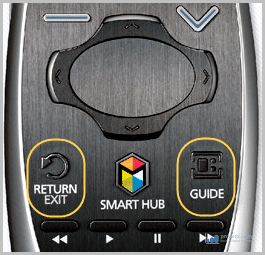
After this, the TV will perform detection again and everything will work again.
Second way. When you turn on the TV for the first time, the Russian language is available and when you press the "Smart Hub" button, the Smart TV menu starts. This is very good:
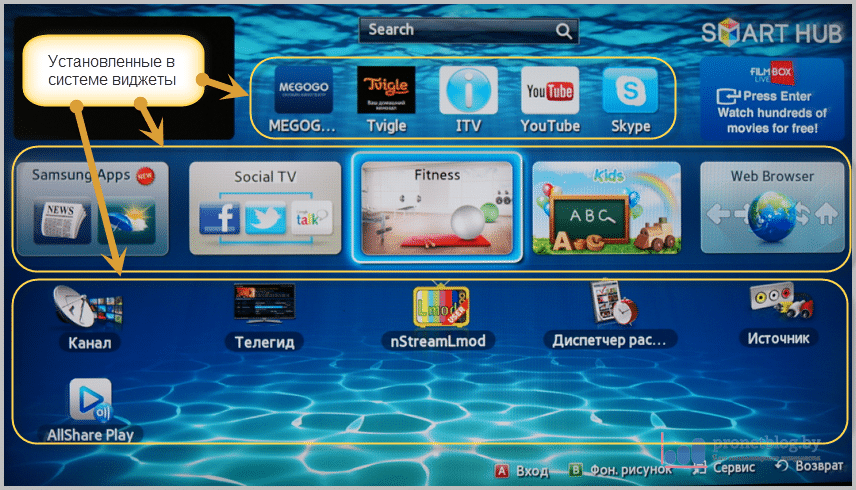 Now look closely at the screenshot above. You see, Russian-language widgets are already installed here, such as Megogo, Twigle and others.
Now look closely at the screenshot above. You see, Russian-language widgets are already installed here, such as Megogo, Twigle and others.
This means that in in this case Smart TV is unlocked. And if you read carefully, then remember that all applications are geo-dependent and are installed depending on the region specified in the settings.
If you also already have widgets in Russian automatically installed and there are plenty of them in the store Samsung Apps, then you don’t have to read any further.
But quite often a situation arises when a TV purchased in an online store already has Russian menu, and Russian-language Smart TV applications are not available for installation.
The reason is an incorrectly set region. To check this setting, select the appropriate link, depending on your TV model.
(for E-series)
While in the "Smart Hub" menu, press the following combination of buttons on the TV remote control:
Rewind >>| 2-8-9 rewind |<<
After this, a list with a selection of countries will open. Select "Russia" or yours:
 Then click "OK".
Then click "OK".
At this stage, the settings for changing the Smart TV region are completed!
Changing the Samsung Smart Hub region. Add Russian widgets(for F-series)
Press the "Source" button on your TV's remote control and select "TV":


Then follow the path "Smart Features":

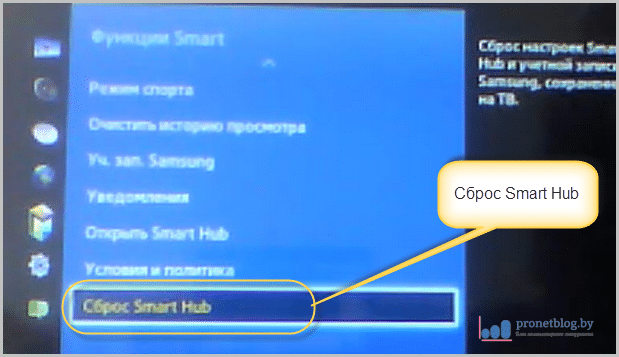

 Once the reset is complete, click "OK":
Once the reset is complete, click "OK": 
Now, without leaving the menu above, click "Open Smart Hub":
 Go to "Smart Hub" accounts:
Go to "Smart Hub" accounts:
 Press the big button and move through the menu until you reach the “Terms and Privacy Policy for Smart Hub” page. Check two boxes:
Press the big button and move through the menu until you reach the “Terms and Privacy Policy for Smart Hub” page. Check two boxes:
 Now, after you have checked the second box, press one of the button combinations below on the TV remote control:
Now, after you have checked the second box, press one of the button combinations below on the TV remote control:
Rewind >>| 2-8-9 rewind |<< Mute / Return / Vol+ / P^ / Mute

After this, a menu will open with a selection of countries. Select "Russia", or your own:
 This will take you back to the Smart Hub Terms and Privacy Policy page.
This will take you back to the Smart Hub Terms and Privacy Policy page.
Again, check two boxes to agree and click “Next”:


That's all! The work on setting up Smart TV is completed.
At the time of writing, these were the only ones I could “discover” on the Internet, on one of the popular forums. I will provide a link to it below.
P.S. My parents have an F-series TV at home, but I still can’t get to them. 🙂
Changing the Samsung Smart Hub region. Add Russian widgets(for H-series)
The method for changing the region for the 2014 H-series is completely identical to the 2013 F-series models. Only the appearance of the menu has been changed.
Therefore, we provide instructions with screenshots using the F-series as an example, and do not be alarmed by minor differences in menu design.
Press the "Source" button on your TV's remote control and select "TV":

 Then follow the path "Smart Features":
Then follow the path "Smart Features":  In the menu that opens, select "Reset Smart Hub":
In the menu that opens, select "Reset Smart Hub":  Enter your security PIN (default is 0000):
Enter your security PIN (default is 0000):  The reset process will start. Wait for it to finish:
The reset process will start. Wait for it to finish: 
Once the reset is complete, click "OK":  Now, without leaving the menu indicated above, click “Open Smart Hub”:
Now, without leaving the menu indicated above, click “Open Smart Hub”:  Then go to "Smart Hub Accounts":
Then go to "Smart Hub Accounts": 
Press the big button and move through the menu until you reach the “Terms and Privacy Policy for Smart Hub” page. Check the box to agree:

Now, after you have checked the box, press one of the button combinations below on the TV remote control:
Rewind >>| 2-8-9 rewind |<< Mute / Return / Vol+ / P^ / Mute

A menu will appear with a selection of countries. Select "Russia", or yours:
 At this step all settings are completed!
At this step all settings are completed!
After you have followed the instructions for changing the Samsung Smart TV region, the required widgets will automatically begin to be installed.
Also, the Samsung Apps store will have applications available for your region. You can select and install.
That's all in principle. Thus, setting up Samsung TV service menu, you can say you saw your pet from the inside. 🙂
By the way, do you want to know even more about your TV? Then welcome to the samez.eu forum. The author of the article also learned a lot from there.
Well, now everything is set! As you can see, everything turned out to be quite simple. All that remains is to wish you a pleasant viewing!
And finally, watch the video as a reminder that you need to work very carefully in the service menu, otherwise there may be consequences like these.
P.S. The latest and most up-to-date information on TVs of 2015 (J-series) can be found. Please take a look if you need it.
Instructions
Log in to the service menu TV Samsung. If you have models SCV11A, TVP3350, TVP5350 or TVP5050, then on the remote control, press the buttons StandBy – P.Std – Menu – Sleep – Power On. After this, it will appear on the screen menu Adjustment. This means that you were able to log into the service menu TV. If you have a CK5038 ZRTBWCX model on an SCT11B chassis, press the following sequence of commands: STAND-BY – P.STD – HELP – SLEEP – POWER ON.
For the CS7272 PTRBWX model on the SCT 51A chassis – press the PICTURE OFF – SLEEP – P.STD – MUTE – PICTURE ON buttons in sequence. If your model TV CS 2139TR, CS-25M6HNQ, CS21A0QWT, CS-21D9, CK-564BVR, CS-21S4WR, CZ-21H12T, or CS-21S1S, then press the hidden button, and then very quickly the following sequence: Stand-By – Pstd – Help – Sleep – Power on. For models made on the KS1A chassis: STAND-BY, then press DISPLAY, then MENU – MUTE – POWER ON.
Enter menu TV Sony models KV-C2171KR, KV-X2901K, KV-X2501K, KV-X2581KR, KV-M2540K, KV-X2581K, KV-M2541K, KV-X2981K, KV-X2101K or KV-X2981KR can be done by sequentially pressing the Display on screen buttons , 5, VOL+, TV, in the upper right corner of the screen TV the inscription TT should appear. If you have models KV-M2101, KV-M2170, KV-M2171 or KV-M1440, put your TV in standby mode, then press the following sequence of buttons on the remote control: ON SCREEN DISPLAY – 5 – VOLUME+ – TV.
Enter menu TVs TELEFUNKEN, THOMSON, BRANDT, FERGUSON, SABA, NORDMENDE, running on the ST92T93J9B1 or ST9093 processor, can be done using the following method. Using the remote control, switch the TV to standby mode and turn it off using the mains switch.
Then press the blue button labeled VT, turn on the power switch. Next, press the VT button again. As a result, a table with the words Setup, Video, Geom will appear on the screen. This is service menu. To exit this mode, click the STAND-BY button.
Search for the key combination to enter the service menu TV on the website http://master-tv.com/article/servise/. At the top of the window, click the first letter of the name of your TV, then select the manufacturer and specific model from the list.
The TV service menu is used for additional settings of the data reception parameter and the transmitted image. To activate it, there are several combinations suitable for different models.
You will need
- Remote control.
Instructions
Pay attention to the release date of your TV model. It is quite possible that if the model was released relatively recently, there are slightly different codes for it. This is due to the fact that this menu is constantly being improved, and as Samsung releases new TVs, a certain program is installed in them, which is launched using different combinations on the remote control.
Take the remote control, quickly and sequentially press the following buttons: MUTE-1-8-2-POWER ON. Please note that it is best not to allow more than 1 second between button presses, as the combination may simply be reset. If you pressed the wrong button, wait a few seconds and start again.
If successively pressing the above buttons does not produce any results, use another code to enter the service menu of the Samsung TV. This may be a combination of info-menu-mute-power, which is most typical for devices of already outdated TV models.
Over time, some TV settings change. This is due to the aging of parts, deterioration of the emission properties of CRTs, and external factors, for example, exposure to electromagnetic fields. Therefore, it often becomes necessary to make certain adjustments to the TV, even if it is working properly. These settings include: restoring white balance, setting the brightness adjustment range, vertical and horizontal centering, adjusting the geometric dimensions of the raster, adjusting color purity, adjusting image focusing, setting the AGC response threshold, etc. Before making adjustments, you should demagnetize the kinescope. If you need to replace electronic components, pay attention to the Dalincom online store, where a wide range of microcircuits, transistors, varistors, relays, thermal fuses, quartz resonators, etc.
Each setting has its own characteristics. Let's consider from beginning to end the process of their implementation for SAMSUNG 2039 TVs. Please note that the described settings are also applicable to other SAMSUNG models made on the KS1A chassis, with 14-, 20- and 21-inch picture tubes.
The setup process begins by entering Service Mode, which is sometimes called Factory Mode. Logging into it is also required when replacing the IC902 memory chip of a TV and CRT.
The service mode is entered from the remote control (RC). To do this, you need to perform the following operations (by pressing the corresponding buttons and selecting a mode):
1. DISPLAY > FACTORY.
2. STAND-BY > DISPLAY > MENU > > MUTE > POWER ON.
The message “SERVICE (FACTORY)” will appear on the screen. The service mode has sections: ADJUST (Settings), OPTION (Options), RESET (Reset).
Access to the setup mode is provided by selecting the appropriate menu item by pressing the VOLUME buttons. In this case, a list of settings is displayed on the screen, the selection of which is carried out using the channel switching buttons (s, t). After selection necessary settings it can be changed up or down using the volume buttons. To exit the service mode, you must press the “FACTORY” or “POWER OFF” button again. The settings are selected in this order:
SCT>SBT>BLR>BLB>RG>GG>BG>VSL>>VS>VA>HS>SC>SDL>STT>SSP>PDL>>NDL>PSR>NSR>AGC>VOL>LCO>TXP.
The purpose of the settings, their ranges of change and default values (factory settings) are given in the table. Column “OSD” - names of settings displayed in the On Screen Display.
| OSD | Purpose of the setting | Adjustment range | Default value |
|---|---|---|---|
| SCT | Subcontrast | 0…23 | 13 |
| SBT | Subbrightness | 0…23 | 9 |
| BLR | Black level (R channel) | 0…15 | 9 |
| BBL | Black Level (Channel B) | 0…15 | 7 |
| RG | Video amplifier gain R | 0…63 | 32 |
| GG | Video amplifier gain G | 0…63 | 25 (fixed) |
| B.G. | Video amplifier gain B | 0…63 | 31 |
| VSL | Vertical tilt | 0…63 | 19 |
| VS | Vertical offset | 0…63 | 38 |
| V.A. | Vertical size | 0…63 | 40 (fixed) |
| H.S. | Horizontal offset | 0…63 | 30 |
| S.C. | S-correction | 0…63 | 9 |
| C.D.L. | Cathode voltage level | 0…15 | 9 |
| STT | Subcolor tone | 0…7 | 3 |
| SSP | Sub-clarity | 0…7 | 0 |
| PDL | PAL signal delay | 0…15 | 15 (fixed) |
| NDL | NTSC signal delay | 0…15 | 10 |
| PSR | Subcolor PAL | 0…23 | 2 |
| NSR | Subcolor NTSC | 0…23 | 5 |
| A.G.C. | AGC response threshold | 0…63 | 23 |
| VOL | Volume preset | 0…63 | 10 |
| LCO | Enabling the IF filter when receiving a SECAM-L system signal | 0…1 | 0 |
| TXP | Teletext location | 0…15 | 9 |
In service mode, through the table for selecting optional settings, you can change the values of some parameters (recommended values of options are given in parentheses):
Turning on the low noise amplifier - LNA (ON);
Selecting a signal receiving system - SYSTEM;
The audio path operating mode is AUDIO (MONO);
Selecting the TV output interface - JACK (RCA);
Selecting the display mode on the screen - ZOOM (NOR/ZOOM/16:9 - normal/enlarged/16:9);
Mode selection automatic shutdown power - AUTO POWER (ON);
Filtering the second IF signal (sound) - 2 nd SIF (ON);
Enabling “hotel mode” - HOTEL MODE (OFF).
The SBL option must be turned OFF and the BKS option must be ON.
Reset mode (RESET) allows you to automatically reset all parameters to default. Wherein automatic modes are set to OFF and the contents of the tuner settings are erased.
Let's look at how to adjust some parameters.
1. Check the high voltage level. First you should check the supply voltage “B+”, which should be +125 V. Then connect a digital kilovoltmeter to the second anode of the kinescope, turn on the TV and set the brightness and contrast levels to a minimum (zero ray current is achieved). In this case, the high voltage should be 27.5 kV. After this, increase the brightness and contrast to maximum. The high voltage level should not change.
2. Adjust the focus of the image. A black-and-white signal is supplied from the test signal generator and the focus control is used to achieve a clear image of the lines in the center of the screen.
3. Adjusting the voltage on the CRT cathodes. It is necessary to connect the oscilloscope probe to the GK terminal of the kinescope panel. A grayscale signal is then supplied from the test signal generator. By pressing the “P” button on the remote control, the standard image size is set. Using the Screen VR variable resistor on the fuel assembly, the signal swing is set to 120±2.5 V (Fig. 1).
4. Adjustment of color purity. Before starting this operation, warm up the TV for 20 minutes. Loosen the screw securing the magnet block (Fig. 2). A white field signal is supplied from the output of the test signal generator. Using an external coil, the kinescope is completely demagnetized. The contrast and brightness adjustments are set to maximum. By moving the magnets forward or backward along the neck of the kinescope, a vertical green stripe appears on the screen (Fig. 3). Carefully move the mixing block. Slowly moving the block of magnets forward, achieve a uniform color of the vertical green stripe and temporarily secure the block of magnets. Alternately, turn on only the blue and only the red cannon, checking the purity of the color of the red and blue fields, respectively. The magnet block is finally secured.
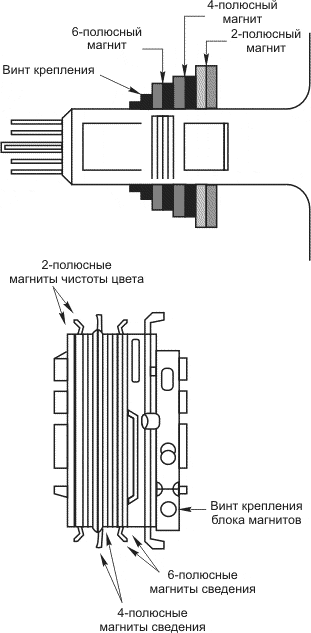
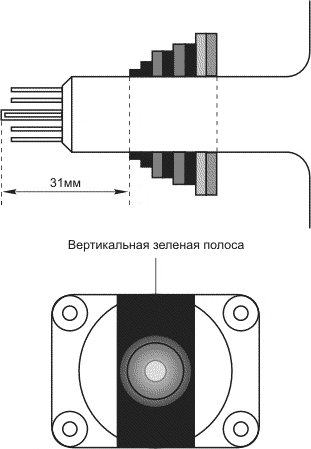
5. Adjustment of information. Warm up the TV for 20 minutes. The grid field signal is given. By rotating the rings of 4-pole magnets, the blue and red vertical lines are brought together in the center of the screen (Fig. 4). By adjusting brightness and contrast, the best image clarity is achieved. By changing the angle between the 4-pole magnets, we achieve the best convergence of the blue and red vertical lines in the center of the screen. By simultaneously rotating both rings of magnets and maintaining the angle set between them, the blue and red horizontal lines are aligned in the center of the screen. 6-pole magnets are rotated in a similar way, achieving alignment of the red-blue lines with the green ones. It should be remembered that changing the angle between the magnets allows you to bring vertical lines together, and their simultaneous rotation allows you to bring horizontal lines together. If necessary, the adjustments are repeated.

6. Setting the AGC response threshold. To do this, in service mode the AGC value is set to 23.
7. Setting the color pre-adjustment signals. When performing this operation, you must set the PSR and NSR values to 2 and 5, respectively.
8. Adjusting the geometric dimensions of the raster. Produced in the sequence: SC > VS > HS. A test pattern signal is supplied to the TV. Set the S-Correction signal value to 9 for 20- and 21-inch CRTs and 0 for 14-inch CRTs, and the VA signal value to 40. By changing the VSL (vertical slant) setting, set the size raster so that four divisions are visible below the circle (Fig. 5). after that, adjust the VS parameter (vertical shift) so that four divisions are visible above the circle (Fig. 6). Finally, by adjusting the HS (horizontal size) parameter, the right and left boundaries of the image are set (Fig. 7).
